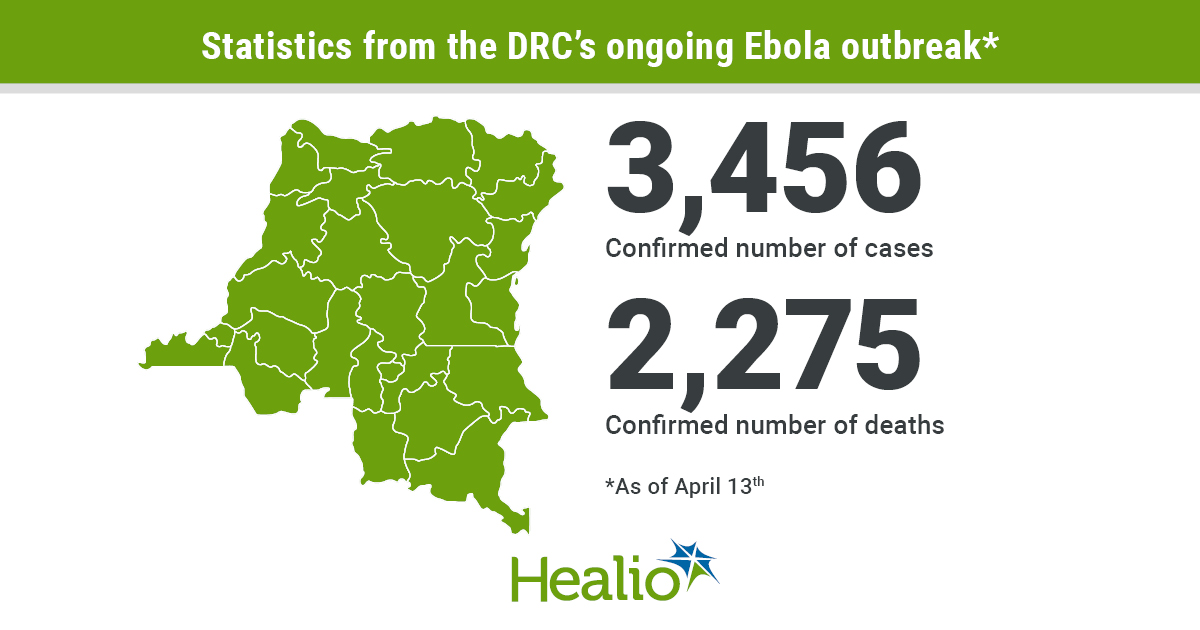DRC Ebola epidemic ‘stubbornly resistant’ to public health measures
On April 10, just 3 days before officials were set to declare the end of the 10th Ebola outbreak in the Democratic Republic of the Congo, or DRC — the second-largest outbreak of the disease in history — a new case was reported. Between April 10 and April 13, reports of three new cases had emerged.
“While not welcome news, this is an event we anticipated. We kept response teams in Beni and other high-risk areas for precisely this reason,” WHO Director-General Tedros Adhanom Ghebreyesus, PhD, MSc, said in a press release.
The outbreak was declared on Aug. 1, 2018, less than 2 weeks after the DRC’s ninth outbreak was declared over. The current outbreak has been a complex emergency since the start because it occurred in a region with a history of armed conflict and political distrust. Attacks on health care facilities and workers, infected patients crossing borders into Uganda and fear of spread to Rwanda led WHO to declare the outbreak a Public Health Emergency of International Concern (PHEIC) in July 2019. The emergency committee met four times before ultimately making the decision.
New in this outbreak, and vital in addition to the PHEIC declaration in containing it, was the widespread use of an Ebola vaccine and the introduction of a second vaccine. The first vaccine, Merck’s V920, was developed to prevent disease caused by the Zaire strain. Preliminary estimates found that the vaccine was more than 97% effective. It was delivered using ring vaccination methods — in which contacts of confirmed cases and contacts of contacts are vaccinated. Throughout the outbreak, hundreds of thousands of people have received the vaccine.
The second vaccine from Johnson & Johnson was introduced more than a year into the outbreak, in October 2019. Officials reserved the vaccine, which is given in two doses 56 days apart, for at-risk populations in areas without active Ebola transmission.

Before the new cases were reported on April 10, 3,453 cases — confirmed and probable — and 2,273 deaths had occurred during the outbreak.
Prior to the new infections, there had been no new cases reported since Feb. 17, and the last confirmed infected patient was discharged from an Ebola treatment center on March 3 after recovering and testing negative for the virus twice. An Ebola outbreak cannot be declared over until 42 days — two incubation periods — have passed since the last exposure to a confirmed case.
“This shows that the Ebola epidemic in the DRC has been stubbornly resistant to public health measures,” Lawrence O. Gostin, JD, professor at Georgetown Law and director of the O’Neill Institute for National and Global Health at Georgetown University, told Infectious Disease News. “The combination of political violence, public distrust and dysfunctional governance in the DRC has constantly posed a major barrier to the Ebola response. Even when we see the light at the end of a long tunnel, we find we must do even more to end this outbreak.”
Tedros called for the emergency committee to meet a fifth time, in which they discussed the ongoing challenges — a low alert rate for suspected cases and deaths, community reticence in regard to emerging cases, the presence of armed groups in the affected area, an unidentified source of infection for these newest patients and the movement of contacts.
According to the emergency committee, the risk for international spread is low, but the committee still considers the outbreak a PHEIC requiring multinational coordination and support.
“We have to anticipate and be prepared for additional small outbreaks. We need the full force of all partners to bring these outbreaks under control and to meet the needs of the people affected,” Tedros said in a prepared statement. “I thank the members of the committee for their advice and I thank the government and people of the DRC, the responders, partners and WHO colleagues, who are dedicated to ending this outbreak.”
Gostin said the DRC must continue to devote major resources to the fight against Ebola.

“The government needs to focus on strengthening its health system and responding to a host of health problems,” he said. “It cannot focus on that sorely needed recovery until the epidemic is officially over.”
He also noted that strengthening the health system is key for the region.
“If it had a robust health system, it would have detected Ebola early [and] responded decisively,” he said. “But it could do neither.”
He says the same would be true should the COVID-19 pandemic get a foothold in the DRC, noting that the country will have trouble procuring personal protective equipment, ventilators and test kits.

“They have to compete with high-income countries on the open global market, which is a hopeless task,” Gostin said. “There’s no plan in place.”
Majid Sadigh, MD, director of the global health program at the University of Vermont Larner College of Medicine/Western Connecticut Health Network, and the first chief medical officer for the second American-built Ebola treatment unit in Liberia during the West African epidemic, echoed Gostin’s concerns, noting that the DRC does not have enough ICU beds, ventilators or intensivists. Because of this, COVID-19 could have a significant impact on the country, despite Congolese efforts. However, he says that — having faced many infectious disease outbreaks in the past — the DRC may have a greater infrastructure to handle a COVID-19 outbreak.
“They are more attuned to epidemics like cholera, hemorrhagic fever like Ebola and yellow fever, and less familiar with respiratory viruses like COVID-19,” Sadigh told Infectious Disease News. “Ebola involves diarrhea and hemorrhagic fever, but COVID-19 is a respiratory disease. Though the DRC is much less familiar with outbreaks of respiratory diseases, it at least has an infrastructure in place for case-finding, contact tracing and isolating infected persons.” – by Caitlyn Stulpin
Disclosures: Gostin, Sadigh and Tedros report no relevant financial disclosures.
